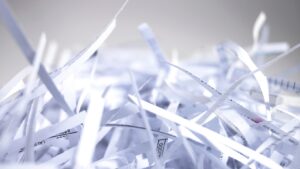Document shredding is an essential part of maintaining the confidentiality and security of sensitive information. It is the process of destroying documents that are no longer needed or have reached the end of their retention period. Whether you’re a business owner, a government agency, or an individual, you should understand the do’s and don’ts of document shredding to ensure that you’re properly disposing of confidential information.
DOs of Document Shredding:
- Use a shredding service that uses a cross-cut shredder: A cross-cut shredder cuts paper into small pieces, making it difficult to reconstruct the document. It is more secure than a strip-cut shredder, which only cuts the paper into thin strips.
- Shred all sensitive documents: Any document containing personal or confidential information should be shredded. This includes financial statements, tax documents, credit card statements, and medical records.
- Follow retention policies: Some documents need to be kept for a specific period of time for legal or regulatory reasons. Once the retention period is over, they should be shredded. Make sure you know the retention period for each document type.
- Shred old credit cards: Credit cards that have expired or are no longer in use should be shredded. Thieves can use the information on old credit cards to commit fraud.
- Do dispose of shredded documents properly, such as by recycling them.
- Securely dispose of electronic media: Electronic media such as CDs, DVDs, and hard drives can also contain sensitive information. They should be shredded or physically destroyed to prevent data breaches.
DON’Ts of Document Shredding:
- Don’t dispose of documents in the trash: Simply throwing sensitive documents in the trash is not secure. Thieves can easily retrieve them and use the information for fraudulent activities.
- Don’t shred documents in-house: In-house shredding can be time-consuming and not always secure. Shredding companies have professional-grade equipment and security protocols to ensure that documents are securely destroyed.
- Don’t put documents that have not been shredded into a recycle bin. Just like a garbage can the documents can be stolen and used by identity thieves for fraudulent purposes.
- Don’t ignore data protection laws: There are laws in place to protect personal data. Make sure you are compliant with these laws when disposing of sensitive information.
- Don’t forget about digital documents: Digital documents can also contain sensitive information. Make sure to securely delete or destroy electronic files when they are no longer needed.
In conclusion, document shredding is a crucial aspect of information security. By following the dos and don’ts of document shredding, you can ensure that sensitive information is securely disposed of and not vulnerable to theft or fraud. Remember to use a cross-cut shredder, shred all sensitive documents, follow retention policies, and securely dispose of electronic media. Avoid disposing of documents in the trash, shredding documents in-house, placing documents in a recycle bin, ignoring data protection laws, and forgetting about digital documents. By following these guidelines, you can protect your personal and confidential information and safeguard against data breaches.
Give FileShred a call today to have your documents shredded as soon as tomorrow.
By
Jim Dowse CSDS
FileShred LLC
(860) 261-9595

